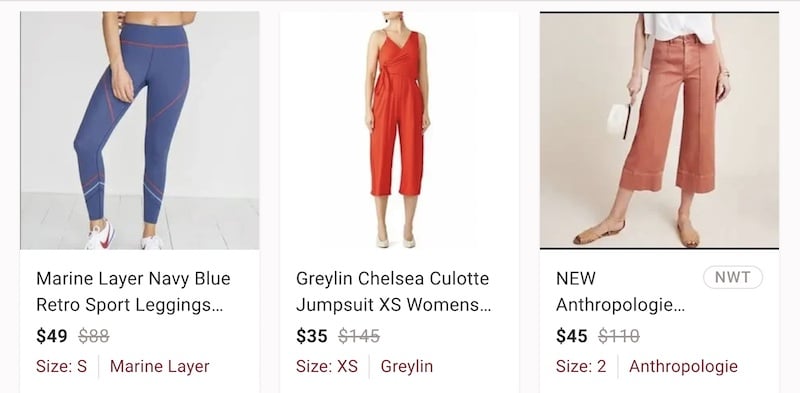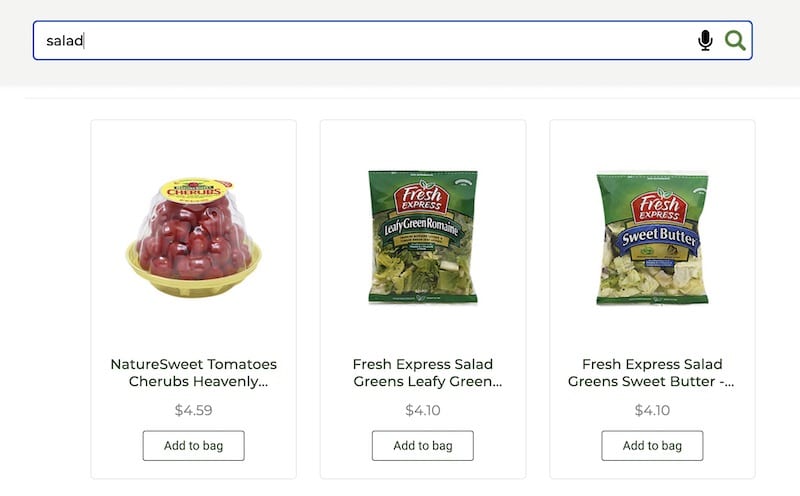Women’s fashion resale marketplace Curtsy found a major flaw in their marketplace searchability.
Converse All-Stars wouldn’t appear in a search query for “all stars.” Instead, users were shown products with “stars” in the description or product title. Everything from jewelry to star-studded pants, tees, and dresses, popped up.
The text-based search of their marketplace UX platform was inherently flawed. It completely missed user intent.
While Curtsy created some workarounds, they were temporary and didn’t quite fix the problem. Some of the persistent issues:
- They bypassed their UX platform with their own machine learning for optimized results, but it was an extensive, manual process requiring a lot of tech resources.
- They stopped promoting search all together and prioritized product feeds instead, but this wasn’t a good customer experience for users looking for specific items.
Curtsy wasn’t alone. For many marketplaces relying on product discovery platforms, their user experience just isn’t cutting it.
But creating custom workarounds and shortcuts doesn’t address the fundamental issue: traditional product discovery platforms aren’t built for the marketplace experience. They create frustrations for shoppers, and they’re not built to retain sellers.
Thankfully, there’s a solution.
Marketplace experience optimized by AI
Marketplace UX is evolving, and better customer experience and seller retention can be achieved with clickstream data, AI, and attractiveness over relevance.
In this article, we’re diving into:
- How poor marketplace UX affects your churn rate and seller retention
- How marketplace UX has evolved for better search
- The top features that improve relevance and searchability
Learn how Curtsy boosted their conversion rate and improved their search experience with Constructor
How does poor marketplace UX impact customer retention?
For sellers and marketplaces alike, profitability matters. If your platform can’t drive your sellers’ revenue, it can’t drive yours. So when site search isn’t on point, even for one product, you’ll drive both shoppers and sellers away.
The lags in many existing marketplaces’ UX expose some glaring issues hindering conversion rates.
There are some challenges marketplace face that we see commonly across all ecommerce verticals:
- Ranking new products
- High inventory turnover (displaying out of stock items)
- Boosting trending and new items
- Personalizing user experience
But there are a few challenges that are unique to marketplaces specifically:
Promoting the most popular sellers’ items doesn’t work well. Not only do you not have control over inventory, but because other sellers won’t be seen. Promoting the products of only a select few popular sellers is not a profitable business model.
Manual merchandising workarounds are even harder than they are in traditional ecommerce. With multiple (or even hundreds or thousands) of sellers and an ever-changing product catalog, it’d be impossible to keep up.
Sellers create their own content. You’re relying on your sellers to write product descriptions that match buyer intent, but they’re not ecommerce copywriters. It’s very common for sellers to create descriptions that don’t contribute effectively to marketplace UX, but it’s impossible to review every product description or properly match keywords to changing catalogs.

Better marketplace search with relevance and attractiveness
Right now, almost all commercial and open-source search solutions optimize for relevance through keyword matching.
Strangely, that actually causes a lot of the confusion and challenges above.
Why?
Relevance may be a buzzword in the search industry, but it doesn’t go far enough.
What’s relevant to one person may not be relevant to the next. Two people might search for a “women’s white shirt,” but one person might be looking for a button-down oxford to wear under a suit and another might be looking for a casual T-shirt.

While relevance is important, it should always be paired with attractiveness: the reality that what users click on, add to cart, and buy is individual behavioral data that you can directly use to provide personalized search results. If the person typing in “white shirt” has a history of shopping for more formal wear or work wear, it would make sense that she’s likely looking for a blouse rather than a T-shirt.
Showing her personalized results increases the chances that she finds something attractive on the first try, but it also solves for the ecommerce KPIs that you care about most, like revenue per visit and unit sales.
Clickstream data takes relevancy and attractiveness into play to reach those goals.
That’s the first step in evolving marketplace UX design: shifting to a mindset of achieving attractiveness through clickstream data.
The only real way to do that is to leverage machine learning and AI to automate as much as possible. You need to be able to apply AI-driven analysis of an individual’s affinities for categories and attributes.
Let’s look at an example of how better AI in marketplace experience plays out:
- Interpreting a user’s behavior, the AI determines their personal purchasing preferences and buying patterns.
- Other users might be buying with the same preferences and patterns. The AI analyzes those patterns and displays products based on them.
- This personalization keeps users on the site and they begin to associate your site as a place for them.
A better experience creates personalization that keeps customers’ eyes on things they enjoy.
They start to associate your market as a place for them. You have everything they like, right? You have everything they’re looking for before they even have to search.
That’s attractiveness leading directly to higher conversion rates. But it’s also a competitive advantage that most marketplaces don’t yet have, leading you to attract more sellers and grow faster.
What should good marketplace UX include?
Sellers are often extremely focused on profitability, which commonly leads to bad practices like keyword stuffing in their product descriptions.
Unfortunately, platforms relying on text-based search inadvertently reward that behavior because their ranking is highly dependent on the keywords showing up within the product and how frequent those words show up.
Customer clickstream data bypasses that, making keywords less of a player (and creating a far better marketplace experience for everyone).
But there are a few other features that really stand out with good marketplace UX design:
- Personalized search results and recommendations
- NLP-powered search
- Inventory management
Personalized search results and recommendations
Searches should change based on what one particular person searches for.
Take grocery shopping online as an example. If a customer searches and buys bread, their suggestion or recommendation should be peanut butter and jelly, or maybe butter. If they convert on yogurt, recommendations may include fruit or granola. Essentially, these recommendations create possibilities to upsell.

Your entire marketplace platform should be an ecosystem that works together to form those connections between products. Clickstream collects your customers’ clicks and what they’re most interested in, but only proper AI can develop those buying connections in real time.
Search enhanced by NLP
Your shoppers are bound to misspell a few things here and there. They’re also likely to describe products differently than the next customer, or even differently than you.
Your audience may be looking for an entryway table, but call it a “narrow table near doorway.” Or maybe they’re looking for a “bedside table”, but there isn’t a listing with those words in the product listing.
They’re likely to see zero results, or at least limited results. Clearly, that’s going to limit how many products your sellers actually sell. No one wants that.
AI-driven search can correct misspellings and use natural language processing to bring up the nearest match to your users’ queries.
This technology virtually eliminates “zero search results” and cuts out the manual labor often needed on other search platforms to achieve better search suggestions.
Inventory management (removing dead ends)
Sellers often have a lot of turnover within their product catalog, along with potentially limited inventory. If your browsing experience only pushes top-selling products and a product sells out, you’re not helping anyone.
This traditional browse and search experience keeps you from ranking products in a meaningful way, impacting conversions all around.
With the evolution of marketplace UX, features like merchant tooling—which uses the same machine-learning algorithms as search tools—can personalize browse pages and optimize them for your top KPIs. You can set global, category, or even attribute-based rules to boost or bury certain items automatically, giving users more attractive search results and giving sellers more exposure to their ideal buyers.
An intelligent product discovery platform should also give you actionable insights into where users are getting stuck or where they’re meeting dead ends (such as the dreaded “zero search results”) so that you can easily eliminate the issue and connect more buyers with more sellers and their products.
The best automatically retrieve analytics and insights from the data you collect as well. So instead of your merchandising team having to manually go in and connect the dots, the product discovery platform surfaces them for you 24/7.
Better marketplace UX is here
Marketplace UX can be challenging with so many different opportunities to create a delightful experience for customers and sellers.
But marketplaces can accomplish better customer experience and seller retention by leaving some of that complexity to an AI product discovery platform designed to adjust to constant change. Revolutionizing marketplace UX, AI and machine learning powered by clickstream data allows marketplaces and sellers to create more personalized shopping experiences and impact their bottom line.
Remember Curtsy? See how Constructor’s AI-based product search and discovery increased their search conversion rate by 10% over Algolia:
How Curtsy Achieved a 10% Lift in Search Conversion Rate with Constructor



